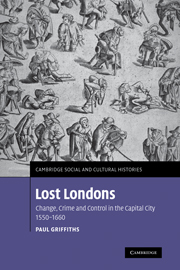2 - Mapping troubles
Published online by Cambridge University Press: 15 December 2009
Summary
‘Little worlds’
Trying to say something definitive about this metropolitan maze is like trying to square a circle. ‘There are so many little worlds in her’, Donald Lupton marvelled in 1632. There were twenty-six wards, 109 parishes, and a mesh of criss-crossing jurisdictions. Wards were split into about 242 precincts, many of which crossed parish lines, blurring borders still further. ‘Many little worlds’, indeed, and many were just small specks on maps but with their own sights, sounds, stench, and stories to tell. London has not one history or even a dozen histories, but hundreds of histories of places, peoples, and cultures. Not one was hermetically sealed from the rest or forked off in one direction on its own. They all crossed constantly like London's streets and jurisdictional patches. These ‘little worlds’ and histories are set in London and they all have something to say about living in the city, but they are not histories of London.
London's quick growth modified mental and physical landscapes and how people experienced the city. These human responses are swamped by growth, and people living 400 years ago can easily get lost in population counts. Londoners made their own environments but each self was affected in some way by place, people, landscape, and living standards. Each Londoner carved out his or her experience and niche in the city, making it their own.
- Type
- Chapter
- Information
- Lost LondonsChange, Crime, and Control in the Capital City, 1550–1660, pp. 67 - 97Publisher: Cambridge University PressPrint publication year: 2008

